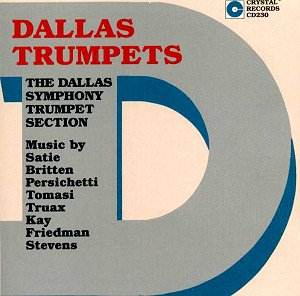Crystal has long made a speciality of the brass,
and the woodwind, repertoire. The bulk of this disc derives from
a 1981 LP – Crystal S230 – with the Persichetti Parable for Two
Trumpets newly recorded and hot off the press. The selection generally
showcases considerable technical dexterity and covers some compositional
ground. There is understandably, given the date of the original
LP, a strong body of work written in the middle to late 1970s;
the earliest is the Satie Carillon Sonnerie, all nineteen potent
seconds of it, which dates from 1921. The latest is Anthony Plog’s
1980 Four Concert Duets.
Bert Truax’s Adagio and Allegro for three trumpets
especially appealed to me. It’s in subtly classical style with
a full and rich slow fugue and a florid variational Allegro that
turns and tumbles over itself delightfully. There’s plenty of
registral exploitation in Henri Tomasi’s Suite with great colour,
depth, tension and dance-like animation and élan. His concluding
Danse Bolivienne has lashings of wit. Persichetti’s Parable for
Solo Trumpet is a structured and intriguing narrative, terse and
powerful, whilst that for Two Trumpets is more puckish than the
solo work. It entwines, coils and is generally more contemplative
and has a strong unison conclusion. The same is true of Britten’s
Fanfare for St Edmundsbury, which is actually three fanfares played
consecutively. Composer Stanley Friedman turns his Antiphonia
IV into a pitch study with a melismatic effect and a singularity
of tension throughout whilst Plog’s Duets are variously flourish-laden
and muted, calm and sensitive and strikingly interjectory with
jagged motifs by the second trumpet adding jazzy syncopations
to the line. Of Stevens’ The Moudon Fanfares the most striking
was the second, Fanfare B.I.M, with its "waspy" pitches,
a piece that thrives on fractiousness and division. There’s a
Satie like economy to his tribute to jazz trumpeter Clifford Brown,
whose ethos he evokes in twenty seconds. Ulysses Kay’s Three Fanfares
end the disc on a note of forthright confidence.
There are plenty of rewards for brass enthusiasts
here in the ways in which the Fanfare can be used, subverted,
extended and elaborated to fruitful musical effect.
Jonathan Woolf
